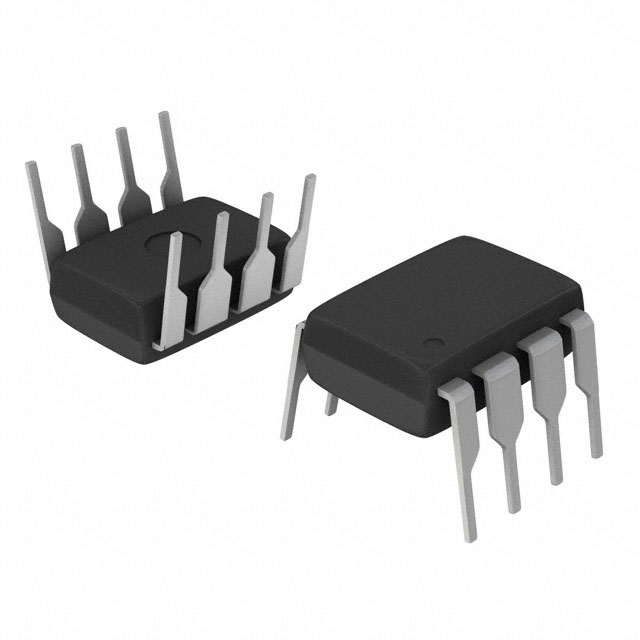AD621BNZ
Product Overview
- Category: Integrated Circuit (IC)
- Use: Instrumentation Amplifier
- Characteristics: High precision, low noise, low power consumption
- Package: DIP (Dual Inline Package)
- Essence: Analog Devices' AD621BNZ is a high-performance instrumentation amplifier designed for precise amplification of low-level signals in various applications.
- Packaging/Quantity: Available in tubes or reels, with quantities varying based on customer requirements.
Specifications
- Supply Voltage: ±2.3V to ±18V
- Input Offset Voltage: 50µV maximum
- Input Bias Current: 40nA maximum
- Gain Bandwidth Product: 800kHz typical
- Input Voltage Range: ±Vs/2
- Operating Temperature Range: -40°C to +85°C
Pin Configuration
The AD621BNZ has an 8-pin DIP package with the following pin configuration:
```
| | --| IN+ V+ |-- --| IN- V- |-- --| REF RG |-- --| GND OUT |-- |___________| ```
Functional Features
- High common-mode rejection ratio (CMRR) of 120dB
- Low input offset voltage and bias current for accurate signal amplification
- Wide supply voltage range allows flexibility in different applications
- Excellent linearity and low distortion for precise signal reproduction
- Internal gain setting resistor for easy customization of gain levels
Advantages and Disadvantages
Advantages: - High precision amplification of low-level signals - Low noise performance for accurate signal processing - Versatile supply voltage range for compatibility with various systems - Compact and robust DIP package for easy integration
Disadvantages: - Limited gain bandwidth product compared to some other instrumentation amplifiers - Higher cost compared to basic operational amplifiers
Working Principles
The AD621BNZ is based on the principle of an instrumentation amplifier, which provides high input impedance, high common-mode rejection, and low noise amplification. It consists of three operational amplifiers configured in a differential amplifier topology with additional gain-setting resistors. The input signals are amplified differentially, rejecting common-mode noise, and providing a high gain output signal.
Application Field Plans
The AD621BNZ finds applications in various fields, including:
- Biomedical instrumentation: ECG, EEG, and EMG signal amplification for medical diagnosis.
- Industrial process control: Amplification of low-level sensor signals for monitoring and control systems.
- Strain gauge amplification: Precise measurement of strain in structural engineering and material testing.
- Data acquisition systems: Accurate amplification of low-level analog signals for data recording and analysis.
- Precision instrumentation: Calibration equipment, test and measurement devices, and scientific research instruments.
Alternative Models
- AD8221: Low power, precision instrumentation amplifier with rail-to-rail output.
- INA128: High precision, low noise instrumentation amplifier with programmable gain.
- LT1167: Precision instrumentation amplifier with low input offset voltage and drift.
These alternative models offer similar functionality and can be considered as substitutes for the AD621BNZ based on specific application requirements.
Word count: 399 words
Lista 10 Vanliga frågor och svar relaterade till tillämpningen av AD621BNZ i tekniska lösningar
Sure! Here are 10 common questions and answers related to the application of AD621BNZ in technical solutions:
Q: What is AD621BNZ? A: AD621BNZ is a precision instrumentation amplifier designed for amplifying small differential voltages in various applications.
Q: What is the voltage supply range for AD621BNZ? A: AD621BNZ operates with a voltage supply range of ±2.3V to ±18V.
Q: What is the typical gain range of AD621BNZ? A: The typical gain range of AD621BNZ is from 1 to 1000.
Q: Can AD621BNZ be used in low-power applications? A: Yes, AD621BNZ has a low power consumption and can be used in low-power applications.
Q: Is AD621BNZ suitable for high-precision measurements? A: Yes, AD621BNZ offers high accuracy and excellent common-mode rejection ratio (CMRR), making it suitable for high-precision measurements.
Q: What is the input voltage range of AD621BNZ? A: The input voltage range of AD621BNZ is typically ±10V.
Q: Can AD621BNZ operate in harsh environments? A: Yes, AD621BNZ is designed to operate in industrial temperature ranges (-40°C to +85°C) and is suitable for harsh environments.
Q: Does AD621BNZ have built-in protection features? A: Yes, AD621BNZ includes built-in protection against overvoltage and reverse polarity conditions.
Q: Can AD621BNZ be used in bridge sensor applications? A: Yes, AD621BNZ is commonly used in bridge sensor applications due to its high input impedance and ability to amplify small differential voltages.
Q: What are some typical applications of AD621BNZ? A: AD621BNZ is commonly used in medical instrumentation, industrial process control, strain gauge amplification, and data acquisition systems.
Please note that these answers are general and may vary depending on specific application requirements.


